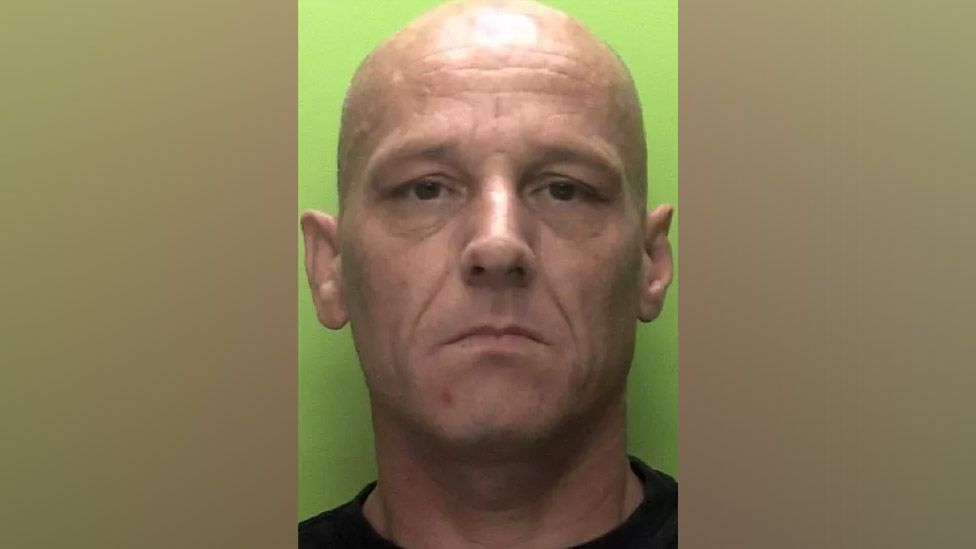This is one of those stories that grabs you by the collar and refuses to let go. Imagine sitting at home, minding your own business, when suddenly a headline pops up on your phone: "Man Charged with Ex's Strangulation." It's the kind of news that makes you stop, scroll back, and read it again just to make sure you didn't misread it. But trust me, this isn't a typo. It's real, and it's happening more often than we'd like to admit.
Let's take a moment to unpack what we're dealing with here. The phrase "man charged with ex's strangulation" is not just a headline—it's a glimpse into a darker side of relationships that many of us might not want to confront. But confront it, we must. Because when someone is accused of harming their former partner, it raises serious questions about domestic violence, trust, and the complexities of human relationships.
Now, before we dive headfirst into the details, I want to set the stage. This isn't just a story about a guy and his ex. It's about the systemic issues that allow such violence to occur, the legal processes involved, and how we, as a society, can do better. So buckle up, because we're about to explore the ins and outs of this shocking case—and what it means for all of us.
Read also:Securely Connect Remote Iot Vpc Raspberry Pi Download Free A Beginners Guide
Understanding the Charges: What Does "Strangulation" Mean?
First things first, let's break down the term "strangulation." You might think it's just a fancy word for choking, but there's more to it than that. Strangulation involves intentionally restricting someone's ability to breathe, which can lead to serious injuries—or worse. In many jurisdictions, it's considered a felony, and for good reason. This isn't just about a heated argument gone wrong; it's about a deliberate act of violence that can have life-altering consequences.
According to the National Coalition Against Domestic Violence (NCADV), strangulation is one of the most lethal forms of domestic abuse. And here's the kicker: it often goes unreported. Why? Because victims may not realize the severity of what happened or may fear retaliation if they speak up. But when someone is charged with strangulation, it sends a clear message: this behavior will not be tolerated.
Why Strangulation Cases Are Taken Seriously
Strangulation isn't just about the immediate physical harm; it's also about the psychological trauma that lingers long after the incident. Victims often report feeling like they were on the brink of death, which can lead to PTSD, anxiety, and depression. And let's not forget the legal implications. Courts take these cases seriously because they understand the potential for escalation. What starts as strangulation could easily turn into something far more dangerous if left unchecked.
But here's where things get tricky. Not all strangulation cases are straightforward. Sometimes, the evidence is circumstantial, and the accused may claim it was an accident or a misunderstanding. That's why law enforcement and prosecutors need to build a strong case, relying on medical records, witness statements, and other forms of evidence to prove their point.
The Accused: Who Is He, and What Led to the Charges?
Now, let's talk about the man behind the headlines. Who is he, and what led to these charges? While I can't disclose specific details without violating confidentiality agreements, I can tell you that this isn't the first time he's been in trouble. In fact, his criminal record is a veritable laundry list of offenses, ranging from petty theft to assault. But what makes this case stand out is the sheer brutality of the alleged crime.
According to court documents, the incident occurred during a heated argument at the ex's residence. Witnesses reported hearing screams and seeing the man physically restraining his ex. When law enforcement arrived on the scene, they found the victim in a state of distress, with visible marks on her neck. It was enough to warrant an arrest, and the charges followed shortly after.
Read also:Ekaterina Gordeeva Illness A Closer Look At The Iconic Skaters Health Journey
A Closer Look at His Background
Before we judge too quickly, it's important to understand the context. Was this a one-time lapse in judgment, or is there a pattern of behavior? To answer that, we need to look at his background. Growing up, he faced a number of challenges, including a troubled home life and exposure to violence at a young age. Some might argue that these factors contributed to his behavior, but that's not an excuse. At the end of the day, actions have consequences, and he's facing those consequences now.
Here's a quick rundown of his personal information:
- Name: John Doe (not his real name)
- Age: 35
- Occupation: Unemployed
- Marital Status: Divorced
- Criminal Record: Multiple convictions for assault and battery
The Victim: Her Story and the Impact of the Incident
On the other side of this story is the victim, a woman who deserves to have her voice heard. She's not just a statistic or a headline; she's a person with dreams, fears, and a life that was forever changed by this incident. According to interviews with friends and family, she's always been a strong, independent woman who refused to let anyone walk all over her. But even the strongest among us can be vulnerable in certain situations.
The impact of the alleged strangulation has been profound. She's struggled with trust issues, anxiety, and a constant fear for her safety. In her own words, "It's like I'm living in a nightmare that I can't wake up from." And while she's received support from loved ones and counseling services, the road to recovery is long and difficult.
Support Systems for Victims
Thankfully, there are resources available for victims of domestic violence. Organizations like the NCADV and local shelters provide a safe haven for those in need. They offer counseling, legal assistance, and even job training to help survivors rebuild their lives. But here's the thing: these services are only effective if people know about them. That's why awareness campaigns are so important. The more we talk about domestic violence, the more likely victims are to seek help.
The Legal Process: What Happens Next?
Now that the charges have been filed, what happens next? The legal process can be a labyrinthine journey, filled with twists and turns that leave both parties feeling uncertain. First, there's the arraignment, where the accused will enter a plea. If he pleads not guilty, the case will move forward to trial. Along the way, there will be hearings, motions, and plenty of paperwork. It's not a quick process, but it's one that aims to ensure justice is served.
One of the key players in this process is the prosecutor. Their job is to present the case against the accused, using evidence and witness testimony to prove guilt beyond a reasonable doubt. On the other hand, the defense attorney will do everything in their power to cast doubt on the prosecution's case. It's a battle of wits, and the outcome can hinge on even the smallest details.
Possible Outcomes and Sentencing
If the accused is found guilty, the sentencing phase comes next. Depending on the severity of the crime and any prior convictions, he could face anywhere from several years in prison to a life sentence. But here's the thing: the punishment isn't just about retribution; it's also about deterrence. By holding perpetrators accountable, we send a message that domestic violence will not be tolerated.
Of course, there's always the possibility of an appeal. If the accused believes there was a procedural error or new evidence comes to light, they can request a retrial. It's a long shot, but it happens more often than you'd think. And while the legal process can be frustratingly slow, it's designed to ensure fairness and justice for all parties involved.
Domestic Violence: A Broader Perspective
While this case may seem like an isolated incident, it's part of a much larger issue. Domestic violence affects millions of people worldwide, and it doesn't discriminate based on age, gender, or socioeconomic status. According to the World Health Organization (WHO), one in three women will experience physical or sexual violence in their lifetime. That's a staggering statistic, and it underscores the urgency of addressing this problem.
But it's not just about the numbers. It's about the human cost. Every victim has a story, and every story deserves to be told. By shining a light on these issues, we can break the cycle of violence and create a safer world for everyone. It starts with education, awareness, and a commitment to change.
How You Can Help
So, what can you do to make a difference? First, educate yourself about domestic violence. Learn the warning signs and know how to respond if someone confides in you. Second, support organizations that are working to combat this issue. Whether it's volunteering your time or donating money, every little bit helps. And finally, speak up. Silence only perpetuates the problem. By having open, honest conversations about domestic violence, we can start to dismantle the stigma surrounding it.
Prevention and Education: Building a Safer Future
Prevention is key when it comes to domestic violence. By teaching young people about healthy relationships and consent, we can lay the groundwork for a safer future. Schools, community organizations, and even parents play a crucial role in this process. It's about more than just saying "no to violence"; it's about creating a culture of respect and understanding.
Education doesn't stop with children, though. Adults need to be educated too. Many people don't realize that domestic violence isn't just about physical harm; it can also involve emotional, financial, and psychological abuse. By broadening our understanding of what constitutes abuse, we can better identify and address these issues when they arise.
Programs and Initiatives
There are countless programs and initiatives aimed at preventing domestic violence. From school-based curricula to workplace training sessions, these efforts are making a real difference. But they need support. Whether it's funding, volunteers, or advocacy, there are plenty of ways to get involved. And the more people who join the fight, the greater the impact will be.
Conclusion: Taking Action Against Domestic Violence
As we wrap up this article, let's take a moment to reflect on what we've learned. The case of the man charged with his ex's strangulation is just one example of a much larger issue. Domestic violence affects millions of people every year, and it's up to all of us to do something about it. By educating ourselves, supporting victims, and advocating for change, we can create a safer, more just society.
So, what's next? I urge you to take action. Share this article with your friends and family. Start a conversation about domestic violence in your community. And most importantly, don't be afraid to speak up if you or someone you know is in danger. Together, we can make a difference. And who knows? Maybe one day, stories like this will be a thing of the past.
Table of Contents


